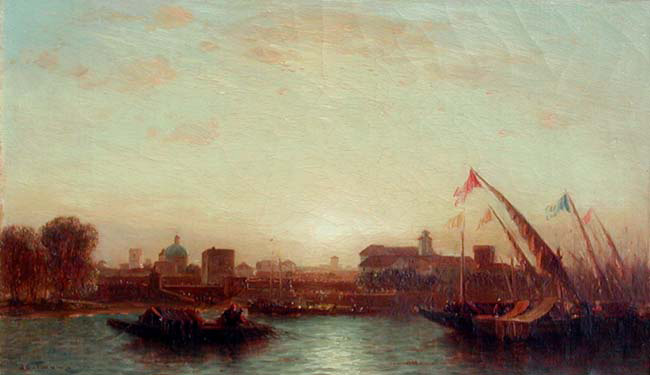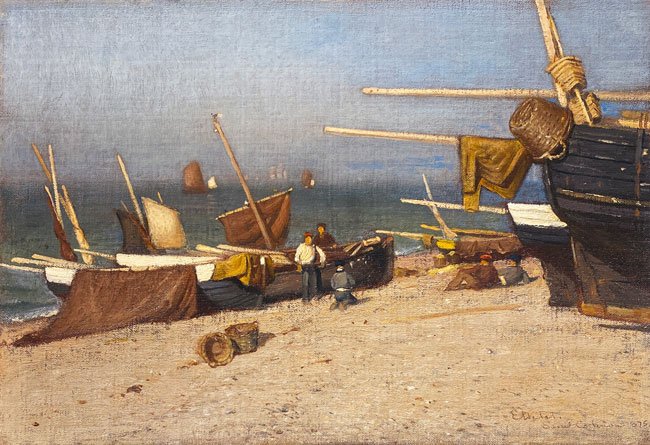SAMUEL COLMAN PAINTINGS FOR SALE & BIOGRAPHY
SAMUEL COLMAN
American, 1832–1920
BIOGRAPHY
Samuel Colman was born in Portland, Maine, in 1832. “His father, Samuel Sr., was a prosperous bookseller and publisher, who later moved his family to New York and opened a publishing house. He published illustrated works by some of the most eminent American authors of the day, including Nathaniel Parker Willis and Henry Wadsworth Longfellow, and his establishment was a favorite gathering place for artists and literati. According to Henry T. Tuckerman, Colman's father "was one of the first tasteful dealers in fine engravings in New York, and his store on Broadway was a unique depository of pictures" (Book of the Artists [1870], p. 559). Young Colman must have become familiar with many examples of engravings and illustrated works, and it is not surprising that he decided to become an artist. He submitted an oil painting entitled Twilight (unlocated) to the National Academy of Design in 1851. Little is known of Colman's formal training, although it has frequently been suggested that he was briefly a pupil of Asher B. Durand in the early 1850s. The landscape pictures he chose to exhibit at the National Academy of Design during those years, like Franconia Mountains, New Hampshire, confirm his concentration on the favorite haunts of the Hudson River school painters, and works like Meadows and Wildflowers at Conway, 1856 (Vassar College Art Gallery, Poughkeepsie, New York), suggest he owes a certain debt to their style, and more specifically to Durand's compositional organization.
“In 1860 Colman went abroad. According to his own account … he spent the following two years in Paris and Madrid ‘engaged in an analysis of the early masters.’ He does not seem to have worked under a teacher, ‘preferring the above method of study.’ He also seems to have devoted himself to observing the romantic architectural sights of southern Spain, notably those of Seville and Granada. He also ventured across the Strait of Gibraltar to Tangier. From these travels, he produced a series of Spanish landscapes, including Gibraltar, ca. 1863 and The Hill of the Alhambra, Granada, 1865... In 1866 he became a founder and the first president of the American Society of Painters in Water-Colors, later the American Watercolor Society. His productions of the late 1860s, like Storm King on the Hudson, 1866 (National Museum of American Art, Washington, D.C.), indicate the progressive fluidity of his style and a looseness of facture which must be credited as much to familiarity with the work of J.M.W. Turner as to his experience with watercolor. By 1870 Colman again sought new subject matter for his landscapes, and he journeyed west, to the Rocky Mountains, following the example of Albert Bierstadt and other American painters before him. In 1871 he exhibited his first frontier scene at the National Academy of Design, Twilight on the Western Plains, inaugurating a series of works depicting the westward voyage of the American pioneer. His wilderness landscapes ceased temporarily at the end of 1871, as he embarked upon an extended tour of Europe. Over the next four years Colman apparently visited several European cities and spent time in Holland and Algeria. Returning to this country at the end of 1875, he concentrated on developing Dutch-like landscape subjects and painting an occasional Arab genre scene. He also turned his attention to the developing vogue for etching, joined the New York Etching Club in 1878, and exhibited his prints in many New England shows. Around the same time he began to take a serious interest in oriental art. He gradually amassed an enormous collection of Japanese objects, including brocades, swords, porcelains, prints, and other exotic items with which he decorated his studio. His interest in the decorative was also witnessed by his collaboration, beginning in the late 1870s, with the firm of Tiffany and Company. He participated in the decoration of numerous interiors, notably the ‘Rembrandt Room,’ the library of the Henry O. Havemeyer house in New York (1890-1891).
“In the late 1880s, Colman apparently resumed his western excursions, visiting Colorado, the Yosemite Valley in California, the Canadian Rockies, and Mexico. He continued to paint an assortment of landscapes with international subjects, although he devoted more and more attention to watercolors. His style grew progressively looser, perhaps under the influence of Barbizon painting, which he had begun to collect years earlier. By 1896 he had ceased exhibiting at the National Academy of Design. His time was taken up writing theoretical treatises on the relationship of mathematics to art.”
[Kathleen Luhrs, ed., American Paintings in the Metropolitan Museum of Art, New York, 1985, Vol. II, pp. 349-350]
Museum Collections:
Art Institute of Chicago, Chicago, IL
Butler Institute of American Art, Youngstown, OH
Brigham Young University Museum of Art, Provo, UT
Brooklyn Museum, Brooklyn, NY
Cantor Arts Center at Stanford University, Stanford, CA
Charles Hosmer Morse Museum of American Art, Winter Park, FL
Columbus Museum of Art, Columbus, GA
Corcoran Gallery of Art, Washington, DC
Frye Art Museum, Seattle, WA
Harvard University Art Museums, Cambridge, MA
Hickory Museum of Art, Hickory, NC
Hudson River Museum, Yonkers, NY
Mariners’ Museum, Newport News, VA
Mattatuck Museum, Waterbury, CT
Mead Art Museum, Amherst College, Amherst, MA
Memorial Art Gallery of the University of Rochester, Rochester, NY
Metropolitan Museum of Art, New York, NY
Museo Thyssen-Bornemisza, Madrid
Museum of Fine Arts, Boston, MA
National Academy of Art, New York, NY
National Gallery of Art, Washington, DC
New York Historical Society, New York, NY
New York Public Library, New York, NY
Parrish Art Museum, Water Mill, NY
Pennsylvania Academy of the Fine Arts, Philadelphia, PA
Rhode Island School of Design, Providence, Rhode Island
Shelburne Museum, Shelburne, VT
Smith College Museum of Art, Northampton, MA
Smithsonian American Art Museum, Washington, DC
Union League Club, New York, New York
Wadsworth Atheneum, Hartford, CT
Yale Center for British Art, New Haven, CT
Mark Murray Fine Paintings is a New York gallery specializing in buying and selling 19th century and early 20th century artwork.
SAMUEL COLMAN
Paintings for sale
Currently there are no available Samuel Colman paintings for sale at the Mark Murray Gallery.
Please contact us if you are interested in selling your Samuel Colman paintings or other artwork from the 19th century and early 20th century.
Samuel Colman Paintings Previously Sold
SAMUEL COLMAN
Sunset, Seville
Oil on canvas
9 x 14½ inches (23 x 37 cm.)
SOLD
SAMUEL COLMAN
Lake Maggiore, Italy
Oil on canvas laid down on board
4¼ x 9¼ inches (10.5 x 23.5 cm.)
SOLD
SAMUEL COLMAN
Fishing Boats, Etretat
Oil on canvas laid down on board
7½ x 11 inches (19 x 28 cm.)
SOLD




